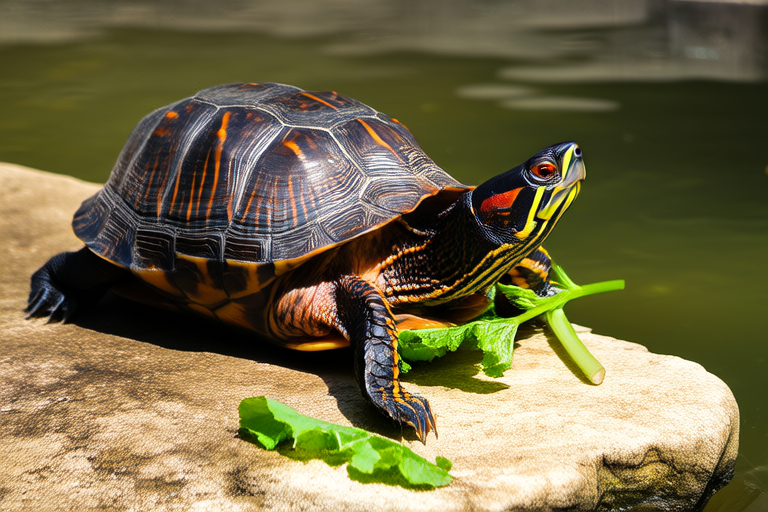Red-eared Slider Care: Common Mistakes Pet Owners Make
The red-eared slider (Trachemys scripta elegans) is one of the most popular pet turtles worldwide. Known for their distinctive red patches behind each eye, these semi-aquatic turtles are often chosen for their charming appearance and relatively low maintenance requirements. However, beneath this seemingly easy-care exterior lies a complex set of needs that many owners fail to meet, leading to a variety of health issues. This article aims to guide both novice and experienced owners through common pitfalls and offer practical advice on how to ensure the well-being of their red-eared sliders.
Inadequate Tank Size
One of the most frequent mistakes made by red-eared slider owners is providing an insufficiently sized tank. A small tank can severely limit the space available for swimming, which is crucial for the physical and mental health of your turtle. Lack of adequate space can lead to stress, stunted growth, and even behavioral problems.
Why It’s Harmful: Insufficient space hinders natural behaviors like swimming, exploring, and basking, which are essential for maintaining muscle strength and overall fitness. Additionally, overcrowding increases the risk of disease transmission among multiple turtles.
Proper Care Instructions: The rule of thumb is to provide at least 10 gallons of water per inch of shell length for juvenile sliders and double that amount for adults. For example, a fully grown red-eared slider with a 10-inch shell would require approximately 200 gallons of water. Ensuring ample room allows for proper exercise and reduces stress.
Poor Water Quality Maintenance
Maintaining clean water is another critical aspect of caring for red-eared sliders. Neglecting water quality can result in harmful bacterial growth, ammonia build-up, and other pollutants that can be fatal to your pet.
Why It’s Harmful: Poor water quality directly impacts respiratory and digestive health. High levels of ammonia and bacteria can cause infections, skin lesions, and even death. Additionally, contaminated water leads to foul odors, affecting the living conditions for both the turtle and its owner.
Proper Care Instructions: Regular partial water changes (30-50% weekly) are necessary to maintain optimal water conditions. Use a high-quality filtration system designed for large aquatic environments, and consider adding beneficial bacteria supplements to promote a healthy ecosystem within the tank. Testing kits are also invaluable tools for monitoring pH, ammonia, nitrite, and nitrate levels.
Incorrect Diet
Feeding red-eared sliders an imbalanced diet is a common oversight. Many owners either overfeed or provide an inappropriate mix of nutrients, leading to obesity, metabolic bone disease, and other serious health issues.
Why It’s Harmful: An improper diet can cause malnutrition, resulting in weakened immune systems and slow growth rates. Overfeeding contributes to obesity, while calcium deficiencies lead to soft shells and brittle bones. Furthermore, feeding inappropriate foods introduces toxins and parasites that can harm your turtle.
Proper Care Instructions: A balanced diet consists primarily of commercial turtle pellets supplemented with fresh vegetables (e.g., leafy greens, carrots), occasional fruits, and protein sources like earthworms or feeder fish. Avoid iceberg lettuce and spinach due to their low nutritional value and potential for causing blockages. Feed young turtles daily, reducing frequency to every other day as they mature.
Insufficient Basking Areas
Basking is vital for red-eared sliders’ thermoregulation, digestion, and overall health. Many owners neglect to provide adequate basking spots, leaving their turtles unable to dry off properly or regulate body temperature effectively.
Why It’s Harmful: Without sufficient basking time, turtles may experience cold stress, making them more susceptible to respiratory infections and weakening their immune responses. Wet skin promotes fungal and bacterial growth, leading to infections and skin disorders.
Proper Care Instructions: Ensure there is enough space above the water where your turtle can completely dry out. Use a UVB light source along with a heat lamp to mimic natural sunlight. The basking area should be large enough for your turtle to stretch out comfortably, and the temperature should reach between 85°F and 90°F (29°C – 32°C). Regular cleaning of the basking platform prevents the accumulation of algae and debris.
Temperature Regulation Errors
Improper temperature management affects nearly every aspect of a red-eared slider’s life, from digestion to activity levels. Maintaining the right temperatures inside and outside the water is crucial for their survival.
Why It’s Harmful: Cold temperatures slow down metabolism, impairing digestion and increasing the likelihood of developing hypothermia. On the other hand, excessively hot environments can lead to dehydration and thermal burns. Both extremes compromise immune function, leaving turtles vulnerable to various diseases.
Proper Care Instructions: Maintain water temperatures between 75°F and 80°F (24°C – 27°C) using submersible heaters. For basking areas, aim for 85°F to 90°F (29°C – 32°C). Invest in reliable thermometers placed both underwater and on land to monitor these conditions accurately. Gradual heating devices prevent sudden temperature shifts that could shock your turtle.
Tips for Maintaining a Healthy Environment
To keep your red-eared slider thriving, follow these additional recommendations:
- Regular Vet Check-Ups: Schedule annual visits to a veterinarian specializing in reptiles. They can perform thorough examinations, administer vaccinations, and address any emerging health concerns early.
- Environmental Enrichment: Provide enrichment activities such as floating logs, tunnels, and plants to stimulate curiosity and encourage exploration. These items add interest to the tank and help reduce boredom.
- Hygiene Practices: Clean the tank regularly, removing waste promptly and performing deep cleans every few months. This practice helps prevent the buildup of harmful substances.
- Handling With Care: Always handle your turtle gently, supporting its body weight properly. Frequent handling can be stressful if done incorrectly, so limit interactions unless necessary.
By avoiding these common mistakes and adhering to best practices outlined herein, you’ll create a nurturing environment that supports your red-eared slider’s longevity and happiness. Remember, responsible ownership requires commitment to learning about your pet’s specific needs and adapting accordingly.
